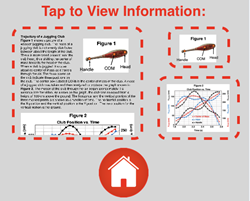About the Science Reasoning Center
 Highly Recommended
Highly RecommendedLike all our Science Reasoning Center activities, the completion of the Trajectory of a Juggling Club activity requires that a student use provided information about a phenomenon, experiment, or data presentation to answer questions. This information is accessible by tapping on the small thumbnails found on the bottom right of every question. However, it may be considerably easier to have a printed copy of this information or to display the information in a separate browser window. You can access this information from this page.
The Standards
The Trajectory of a Juggling Club activity requires that students interpret a complex graph depicting the x- and y-position of three points on a juggling club as it rotates about its center of mass while traveling through the air. Success with the activity requires some degree of proficiency with respect to ...
- Analyzing and Interpreting Data (Science and Engineering Practice 4.1)
Analyze data using tools, technologies, and/or models (e.g., computational, mathematical) in order to make valid and reliable scientific claims. - Using Mathematics and Computational Thinking (Science and Engineering Practice 5.3)
Use mathematical, computational, and/or algorithmic representations of phenomena to describe and/or support claims and/or explanations.
While the Trajectory of a Juggling Club activity addresses the two NextGen Science and Engineering Practices above, the activity drew its greatest inspiration from ACT's College Readiness Standards for Science Reasoning. The relationship between the questions and the standards is as follows:
- The Apprentice Difficulty Level addresses IOD 401 (IOD = Interprettation of Data)
Select data from a complex data presentation. - The Master Difficulty Level addresses EMI 601 (EMI = Evaluation of Models, Inferences, and Experimental Results)
Determine which complex hypothesis, prediction, or conclusion is, or is not, consistent with a data presentation, model, or piece of information in text. - The Wizard Difficulty Level addresses IOD 701 (IOD = Interprettation of Data)
Determine which complex hypothesis, prediction, or conclusion is, or is not, consistent with two or more data presentations, models, and/or pieces of information in text.
Recommended: Print Passage, Tables, and Graphs
Also see: